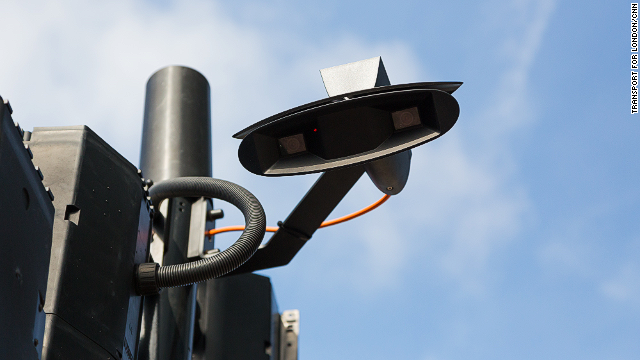Pedestrian-counting cameras to replace London traffic cops
Call it the traffic version of “I Spy”: A smart camera system is fulfilling traffic cop duties in London, reports CNN, by counting crowds of people and granting them more or less time to cross the road. Pedestrian SCOOT (Split Cycle Offset Optimization Technique) relies on high-tech video cameras to determine the number of pedestrians at a crossing. Once the cameras calculate a “critical mass,” the “Walk” sign remains lit longer to allow for more people to make their way across the street. Conversely, when there are fewer pedestrians waiting to cross, it gives more green lights for traffic.

A SCOOT camera, from CNN.com.
An existing SCOOT system is already implemented in London, where it is used to regulate traffic at 3,000 intersections; a 12% reduction in traffic delays is already attributable to the system. But the Pedestrian SCOOT system is new, with trials beginning this past summer. The “vision-based system” is equipped with a stereoscopic camera that enables sensors to “see” and count crowds in three dimensions. (The stereoscopic camera provides depth, so that it can count people and not include shadows or other objects, unlike traditional cameras.)
Explains Mark Cracknell, team leader of the Technology Delivery Group at Transport for London, “Our SCOOT system has been used around the world for many years use to optimize and coordinate the traffic signal junctions and we’ve done that currently and historically for vehicles… We have inductive loops in the road that detect vehicles, do clever analysis of the traffic patterns and then coordinate the junctions to try to make the progress through the city as smooth as possible.”
Pedestrians in London presently have six seconds to make it to the road before crosswalk signs’ countdowns begin, letting them know how many more seconds they have to cross. The new Pedestrian SCOOT system will respond to pedestrian numbers. Notes Cracknell, “If there’s only a few people waiting we’ll just go for the standard six seconds to cross, but if we’ve got 100 people waiting to cross we can increment that up to the appropriate time. What we’re avoiding is the scenario where we don’t have enough time to get everybody on the crossing and then pedestrians have to wait for another cycle of the traffic signals to get across.”
More than 270,000 pedestrians are killed each year throughout the world. In the U.S., for example, 4,432 pedestrians died in traffic crashes in 2011, with a 3% increase from the 2010 figure, according to NHTSA data. Promisingly, the United Kingdom saw an 8% drop in pedestrian fatalities between 2011 and 2012, according to data from Parliament.
The Pedestrian version of SCOOT — which is, according to Transport for London, the first of its kind — would potentially have the greatest impact in areas where foot traffic varies, such as outside a train station or school. “During the day there might be a low flow and you don’t want to be fixed with a high crossing time when there’s no one there,” Cracknell tells CNN. “There are technologies out there that can detect whether a pedestrian is waiting, but the technology we use actually quantifies and counts the number of people.”
The system may eventually include another feature, called “call cancel technology,” which is currently being tested and would address a potentially problematic scenario: when a pedestrian has changed her mind and crossed or otherwise left the intersection before receiving a green signal.
Pedestrian SCOOT is part of London’s goal to reduce the number of fatalities and serious injuries on its streets by 40% by the year 2020.
Category: Pedestrian safety, Resources




